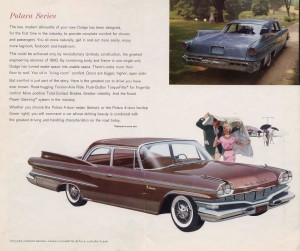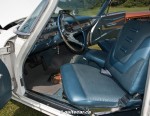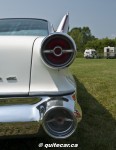1960 Dodge Polara
Virgil Exner’s “Forward Look” radically changed Detroit’s automotive design philosophy in 1955.
By the age of 30, Virgil Exner, was was in charge of the styling for the Pontiac division of General Motors under the watchful eye of Harley Earl, GM’s styling czar. In 1938 he was given an offer by Raymond Lowey’s industrial design firm, Lowey and Associates, he couldn’t refuse. As well as working on designs for military vehicles and the 1939-40 Studebaker cars he was all so tasked with planning for Studebaker’s post-war cars.
Studebaker was unsure of it’s relationship with Lowey and Associates and Roy Cole, Studebaker’s engineering vice president asked Exner to work on back-up designs. 1944 he was fired by Lowey and hired by Studebaker. Though publicly the design for the highly acclaimed 1947 Studebaker Starlight coupe was credited to Lowey, the final design was Exner’s.
Virgil Exner left Studebaker when rivalry between Lowey and himself came to a head. Engineering chief of Studebaker, Roy Cole introduced Exner personally to both Ford and Chrysler management. Chrysler took him on and Exner gained control of the design process. At the time Chrysler cars were being designed by the engineering department and were considered to be outmoded and un-stylish.
 Inspired by Cadillac’s use of fins on it’s 1948 designs, Exner used them as the central element in his “Forward Looking” designs. As well as liking the visual aspects of fins he believed that their were aerodynamic benefits as well and had the University of Michigan perform wind tunnel tests on his designs.
Inspired by Cadillac’s use of fins on it’s 1948 designs, Exner used them as the central element in his “Forward Looking” designs. As well as liking the visual aspects of fins he believed that their were aerodynamic benefits as well and had the University of Michigan perform wind tunnel tests on his designs.
By lowering the roof-line and making the cars sleeker and more aggressive looking Chrysler soon moved into the for-front of public attention and caused both General Motors and Ford to catch up. “The New 100-Million Dollar Look” was introduced in 1955 by Chrysler with it’s 300 series car, featuring a longer hood and wedge-like design. By 1957 Chrysler had revamped all it’s models and Plymouth was using the advertising slogan “Suddenly, it’s 1960!”
In 1960 Dodge introduced it’s top-of-the-line Polara. The name was is a reference to the Polaris star and was chosen by marketing as an attempt to capitalize on the interest in the space race. It was originally slated to compete with Ford’s Galaxy 500 and Chevrolet’s Impala. Dodge would continue using the name until 1973.
In 1960 John Lynne, Frankford Ont. was 17 years old and a friend of his father had purchased a pink Dodge Polara. John got to ride in the car two or three times.
“I was awestruck by the car,” John remembered.
During a visit to the cruise night in Kemptville Ont., John was going through their photo album he saw a photograph of a 1960 Dodge Polara owned by Ivan Wallace, Greely Ont. but was unable to track down the owner. In May 2003 at the Stirling Annual Automotive and Antique Flea Market he encountered a man who claimed he had a 1960 Dodge Polara. In June he got a call from the owner and purchased the car.
The Polara had less than 100,000 miles (160,000 kms.) on it and has a 383 cid. with a 2-barrel carburetor. Other than a few missing trim pieces the car was complete.
John is a retired school teacher (1998) and has a had a love affair with old cars all his life. His first car was a 1949 Dodge he purchased for $50. John currently is restoring a 1937 Ford Cabriolet convertible.









